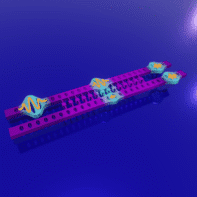
A team of researchers in Sweden has demonstrated how smart optical metasurfaces can respond far more strongly to incoming light when switched to their conducting states. By fine-tuning the spacing between arrays of nanoantennae on a polymer metasurface, Magnus Jonsson and colleagues at Linköping University were able to generate nonlocal electromagnetic coupling between the antennae – vastly strengthening the metasurface’s optical responses.
Metasurfaces are rapidly emerging as a key component of smart optical devices, which can dynamically manipulate the wavefronts and spectral signals of incoming light. “They work in a way that nanostructures are placed in patterns on a flat surface and become receivers for light,” Jonsson explains. “Each receiver, or antenna, captures the light in a certain way and together these nanostructures allow the light to be controlled as you desire.”
One promising route towards such intelligent metasurfaces is to fabricate their antennae from conducting polymers, such as PEDOT. In such materials, the intrinsic permittivity – which determines how the material responds to electric fields, such as those from incoming light – can be manually switched by altering the oxidation state through a redox reaction. This, in turn, modifies the polymer’s carrier density and mobility, altering the number and behaviour of mobile charge carriers that contribute to its optical properties.
A key measure of how well these materials resonate with light is the “quality factor”, which describes how sharp and long-lived a resonance is. A higher quality factor signifies a stronger, more precise interaction with light, while a lower value indicates weaker and broader responses.
When PEDOT is in its metallic oxidation state, incident light will drive the resonance of surface plasmons: collective oscillations of mobile charges that are confined near the surface of the material. At specific wavelengths, these plasmons can strongly enhance electromagnetic fields – altering properties including the phase, amplitude and spectral composition of the light reflected and transmitted by the metasurface.
Alternatively, when PEDOT is switched to its insulating state, the resulting lack of available charge carriers will significantly suppress surface plasmon formation, leading to diminished optical response.
In principle, this effect offers a useful way to modulate the nanoantennae of smart metasurfaces via redox reactions. So far, however, the surface plasmons generated through this approach have only resonated weakly in response to incident light, and have quickly lost their energy after excitation – even when the polymer is switched to its metallic state. This has made the approach impractical for use in smart, switchable metasurfaces that require strong and coherent plasmonic behaviour.
Jonsson’s team addressed this problem by considering the spacing of PEDOT nanoantennae within periodic arrays. When separated at precisely the right distance, the array generated nonlocal coupling through coherent diffractive interactions – involving the constructive interference of light scattered by each antenna.
As a result, this arrangement supported collective lattice resonances (CLRs) – in which entire arrays of nanoantennae respond collectively and coherently to incident light. This drastically boosted the strength and sharpness of the material’s plasmonic response, boosting its quality factor by up to ten times that of previous conducting polymer nanoantennae. Such high-quality resonances indicate more coherent, longer-lived plasmonic modes.
As before, the researchers could manually switch the nanoantenna array between metallic and insulating states via redox reactions, which reversibly weakened its plasmonic responses as required. This dynamic tuning offers a pathway towards electrically or chemically programmable optical behaviour.

Reconfigurable metasurface steers incoherent light in less than a picosecond
Based on this performance, Jonsson’s team is now confident that this approach could have promising implications for the future of smart optical metasurfaces. “We show that metasurfaces made of conducting polymers seem to be able to provide sufficiently high performance to be relevant for practical applications,” says co-author Dongqing Lin.
For now, the researchers have demonstrated their approach across mid-infrared wavelengths. But with some further tweaks to their fabrication process, allowing for closer spacings between the nanoantennae and smaller antenna sizes, they aim to generate CLRs in the visible spectrum. If achieved, this could open up new opportunities for smart optical metasurfaces in cutting-edge optical applications as wide-ranging as holography, invisibility cloaking and biomedical imaging.
The study is described in Nature Communications.



